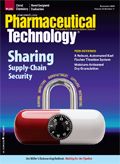Facing Reality
Contract organizations waiting for the pipeline to come roaring back are kidding themselves.
A popular definition of insanity defines it as repeating the same task over and over again while expecting a different result. Using that definition, it would appear that a lot of people in the contract-services industry think that the major global biopharmaceutical and pharmaceutial companies are insane. That's because they expect the major companies to continue to seek new drugs the way they have in the past—that is, by throwing a lot of money at a lot of new drug-development candidates in hopes that a few of them will make it to commercial approval.

Jim Miller
Are the major drug companies really that crazy?
The dismal track record of the biopharmaceutical and pharmaceutical industry for new drug development is well known. Since 1996, the number of drugs in development has doubled, and company spending on research and development (R&D) has tripled, but the number of new molecular entities (NMEs) approved by the US Food and Drug Administration has dropped by half. The cost of developing a new drug has soared to more than $1 billion, and the phrase "R&D productivity" has become an oxymoron.
Until recently, the failure of R&D at the major biopharmaceutical and pharmaceutical companies has largely been a failure of strategy. Their pursuit of the next blockbuster led them to undervalue a candidate with a mere $500-million market opportunity. They maintained their historical focus on technologies that were reaching their limits of efficacy and safety, like nonsteroidal anti-inflammatory drugs, while ignoring the promise of monoclonal antibodies and other large molecules. They pursued economies of scale in R&D operations but wound up building unwieldy and unproductive bureaucracies.
Reducing pipeline dependence
In recent years, however, global pharmaceutical companies have made dramatic moves to reduce their dependence on the new product pipeline. Through mergers, acquisitions, and licensing deals, they have diversified their business portfolios into new business opportunities not dependent on new products. These portfolios now include emerging markets and generic drugs, and they address technology gaps, especially with regard to biologics.
At the same time, the large biopharmaceutical and pharmaceutical companies have hacked away at their traditional R&D model, closing R&D facilities, terminating large numbers of development candidates, and exiting entire therapeutic areas. They are experimenting with new organizational structures such as Eli Lilly's (Indianapolis) Chorus initiative, that are aimed at finding ways to spend less on drug discovery and early development, where a high percentage of candidates fail. Identifying unpromising candidates sooner, and killing them quicker, is now a major objective of the drug-development process.
Recent developments in the commercial environment will drive biopharmaceutical and pharmaceutical companies to reduce their spending on new products even further. Regulatory bodies are making commercial approval of new products ever more difficult out of concern for patient safety and to encourage drug companies to develop products that are better than what is already on the market.
In the meantime, pressure on drug prices is intensifying, making it increasingly difficult to make a financial return on new drugs. The insurance companies and governments that pay most of the tab for new drugs are refusing to reimburse payments for some new drugs, demanding use of generic products, stiffening price controls, and in some countries, paying for certain drugs only if the patient shows progress.
Venture capital pullback
Although the major drug companies are looking to reduce their drug-development spending, another major source of R&D spending is also likely to decline. Venture capital has fed the growth of the early development pipeline for the past 10 years, pumping more than $1 billion per quarter into US biopharmaceutical and pharmaceutical start-ups.
The global financial crisis has changed the outlook for venture capital dramatically, however. It has made the major investors in venture capital funds, pension funds, and university endowments much more risk averse—and contributions to those funds are declining. The economic downturn has also highlighted the fact that returns on venture capital during the past 10 years have not been significantly better than returns on less risky investments, including stocks and bonds. This is a direct reflection of the fact that far too much venture capital has chased too few worthwhile opportunities.
Coming to terms
The contract-services industry needs to come to terms with the fact that the new-product gravy train is coming to an end. The number of candidates in development is shrinking, and the amount spent on them is falling. R&D spending by small bio/pharma companies dropped 20% in the first half of 2009, and the large and mid-size companies slowed their spending. We may get a bounce up in the second half of the year as some delayed programs are accelerated, but the trend seems pretty clear.
A decline in R&D spending will hurt smaller contract research and manufacturing organizations (CROs and CMOs) the most, because it will be concentrated in the discovery, preclinical, and Phase I segments of the pipeline. Those are the segments that will feel the greatest effects of the venture capital pullback, and the venture-backed biopharmaceutical and pharmaceutical companies are the most dependent on contractors.
The large public CROs and CMOs will also feel the heat, however. Their stock prices were driven up to record levels during mid-decade, as high double-digit revenue and profit growth rates became the norm. Those growth rates have slowed dramatically, and aren't likely to reach their pre-2008 levels. Phase II and Phase III research programs have been well-supported thus far, but efforts to kill likely failures more quickly will ultimately shrink the late-stage pipeline.
CROs and CMOs benefit from the increased willingness of the major biopharmaceutical and pharmaceutical companies to outsource more of their development activities. However, much of that benefit will accrue to large CROs and CMOs, and to service providers with operations in the emerging markets.
Owners and investors of contract-service providers must come to terms with this new reality. The venture capitalists and executives of the major companies are not insane, and they have already turned away from the practices that fueled the great pipeline explosion of this decade. CROs and CMOs will need to find other ways to fuel their growth.
Jim Miller is president of PharmSource Information Services, Inc., and publisher of Bio/Pharmaceutical Outsourcing Report, tel. 703.383.4903, fax 703.383.4905, info@pharmsource.com, www.pharmsource.com.

Drug Solutions Podcast: A Closer Look at mRNA in Oncology and Vaccines
April 30th 2024In this episode fo the Drug Solutions Podcast, etherna’s vice-president of Technology and Innovation, Stefaan De Koker, discusses the merits and challenges of using mRNA as the foundation for therapeutics in oncology as well as for vaccines.